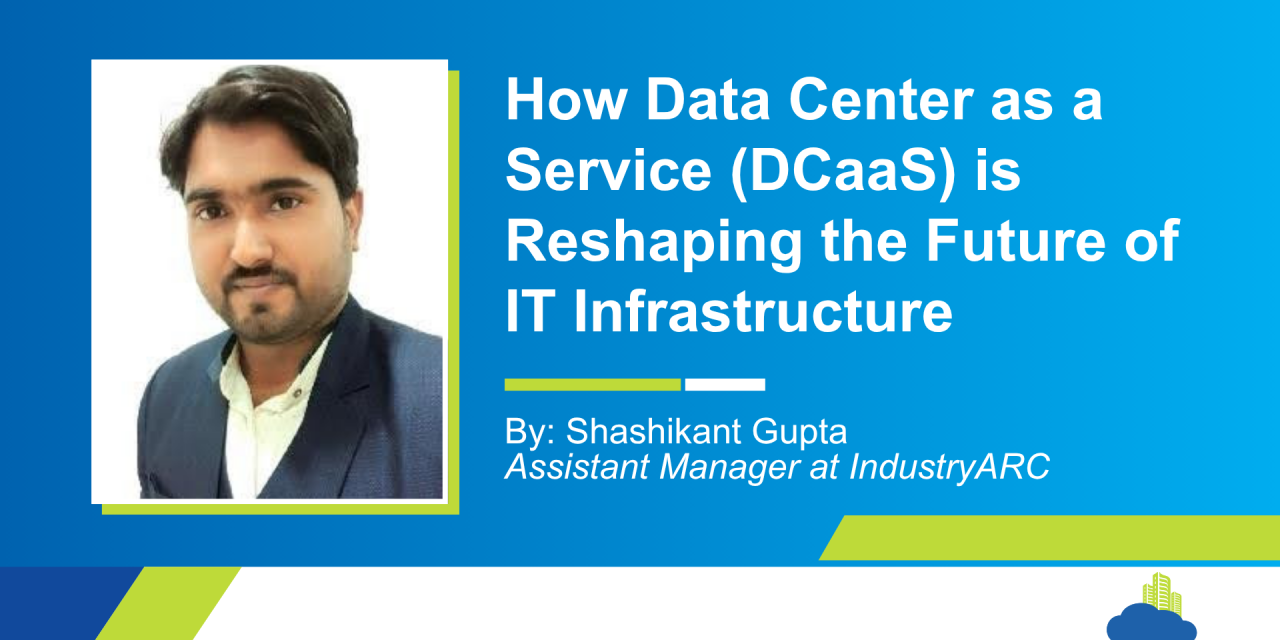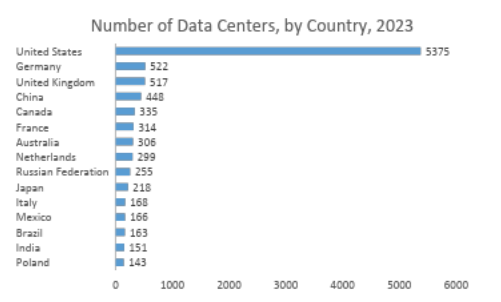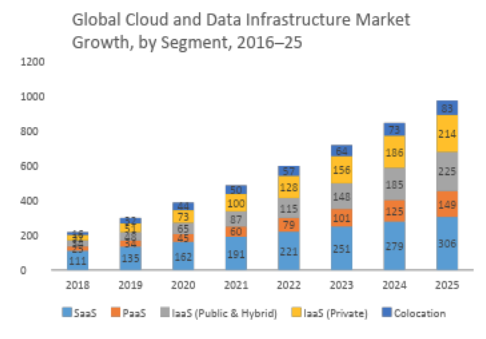Data Center as a Service Market Overview
The global data center as a service market is expected to grow at a compound annual growth rate of 21.2% from 2024 to 2030 reaching USD 267,829.1 million in 2030. The growing use of cloud-based solutions, need for innovative and economical data management and the growing requirement for secure, legal and adaptable data center services to simplify digital transformation are the main drivers of this strong growth.
The Market for Data Centers as a Service: Transforming Digital Infrastructure
In the digital age, Data Center as a Service (DCaaS) has become a key option to transform the way both individuals and corporations manage their IT infrastructure. This model enables efficient storage and recovers of data and projects by providing on demand access to adaptable data center resources. Small and medium sized businesses can improve significantly from DCaaS since it allows them to take advantage of innovative infrastructure without having to make large capital investments and leveling the playing field in markets with strong competition.
What is Data Center as a Service?
A data center is a centralized location that houses the essential computing components that make up an organization’s IT operation such as servers, storage systems and networking. Businesses can now take advantage of data center’s power without having to worry about managing and controlling physical infrastructure thanks to a current solution called DCaaS that provides these resources as an innovative, adaptable service that is usually run by outside providers. This model simplifies operations and lowers costs by giving organizations on demand access to enterprise level infrastructure.
Key Factors Shaping the Data Center as a Service Market
The core of the data center as a service market are data centers, which offer the essential infrastructure for data management and cloud computing. Enterprise data centers are owned and operated by businesses for their internal IT needs. Colocation facilities are places where companies rent space to house their servers and equipment. Low- and middle-income nations face challenges in growing their data center as a service market. Problems like inconsistent electricity and weak internet connectivity hold them back. In comparison high-income countries attract more investment. This is due to their strong infrastructure and reliable services. Despite these challenges data centers continue to be essential for satisfying the growing global need for innovative effective cloud solutions.
Source: Cloudscene, World Bank
Government’s Role in Boosting the Data Center as a Service Market
Governments are helping grow the Data Center as a Service (DCaaS) market by supporting digital transformation and using cloud technologies. Through cloud-first or cloud-smart policies, they encourage cloud services such as, Infrastructure as a Service (IaaS), Platform as a Service (PaaS) and Software as a Service (SaaS), especially in middle- and high-income countries. To increase flexibility, many also use hybrid and multicloud setups that mix public and private cloud systems. Governments are also setting basic rules for how data is organized and managed to make this shift smooth and secure.
Source: Roland Berger, World Bank
Unlocking the Data Center as a Service Market’s Potential: Key Approaches
1. Deploy Solutions for Scalable Infrastructure
Businesses can incorporate advanced infrastructure solutions like virtualization, hybrid cloud environments and automated resource management tools by implementing DCaaS. By empowering IT teams to flexibly distribute computer resources that ensure optimal results without going overboard. Organizations can maintain operational flexibility while scaling networking, processing power or storage to meet changing demands by switching to a service-based architecture.
2. Enhance Operational Resilience
The major advantage of DCaaS is to reduce disruptions. DCaaS ensures that workload continues to function during maintenance or unplanned disruption. By lowering dependency on any one system by this strength enables businesses to continue operating and providing reliable services even when faced with technological difficulties.
3. Collaborate with Strategic Partners
To successfully handle the challenges of DCaaS adoption it is essential to collaborate with an experienced industry specialist. A reliable advisor can identify the specific needs of an organization that match DCaaS solutions to legal and regulatory requirements. It also analyzes the economic feasibility of cloud-based systems that ensures that DCaaS investments are tailored for maximum value. The advisor helps businesses meet short-term needs and long-term goals.
Key Advantages of the Data Center as a Service (DCaaS) Market
1. Scalability for Upcoming Development
DCaaS removes limits like old hardware or not enough space and helps companies scale easily. It lets them adjust bandwidth, storage or power when launching new services or expanding. This way, they can meet new needs without spending a lot on upgrades. It also saves time as there’s no need to set up everything from scratch. Teams can focus more on their work instead of managing servers.
2. Increased Efficiency in Operations
DCaaS helps by using cloud tools that manage resources and launch apps faster. This makes IT work better and services run more smoothly. It also helps teams respond faster to customer needs. As a result, businesses stay competitive and grow faster.
3. Economical Infrastructure Administration
Running a data center can be costly with hardware, maintenance and electricity bills. DCaaS offers a more budget-friendly option by using a subscription model. This means no heavy upfront cost and lower day-to-day expenses. It allows companies to use that saved money on key projects or new ideas. And they still get stable and high-performing IT systems.
Key Drivers of the DCaaS Market
1. Cost-effectiveness and Lower Capital Outlays
Building and running a traditional data center costs a lot. For small and mid-sized companies, these costs can be too much. They need to buy servers, cooling units, space, and hire experts. DCaaS solves this with a pay-as-you-go model that cuts big upfront costs. Companies get access to top-level infrastructure without spending huge amounts. For example, colocation centers offer better security and room to grow. That’s why many businesses choose them instead of building their own setup.
2. Growth of IoT and Connected Devices
The rise of connected devices from factory sensors to smart home gadgets are driven by IoT. These devices create huge amounts of data that need quick processing and storage. To handle this, DCaaS providers bring infrastructure closer to where data is made. Edge data centers help cut down delays and boost performance. This makes it easier for businesses to work in real time and serve users faster.
3. Cloud Adoption and Digital Transformation
Cloud computing has become essential for business as digital transformation grows worldwide. Now companies are using a mix of public and private clouds to manage cost, security and scale. DCaaS supports this shift by offering flexible systems that work with both cloud types. For example, AWS shared that demand for hybrid cloud went up by 30% in 2023. This growing need is one of the main reasons DCaaS is expanding so fast.
Emerging Trends in the DCaaS Market
The DCaaS market shifts quickly, with several trends shaping its future:
Sustainability and Green Data Centers
The IEA says global electricity use by data centers could double by 2030 and will reach around 945 TWh. That is slightly more than what Japan uses in total today due of this sustainability has become a big focus. DCaaS providers are now investing in clean energy and efficient tech to cut down their impact
Advanced Cooling Technologies
AI and high-performance computing are making data center racks use more power. Due to this new cooling methods such as liquid immersion and direct to chip cooling are becoming essential. Equinix shared the plans to expand liquid cooling in over 100 of its data centres by December 2023. These cooling systems help manage powerful AI hardware while saving energy. They also let data centers handle modern, high-demand applications more efficiently.
Regional Insights
The DCaaS market is thriving globally, with distinct regional dynamics:
North America
Big hyperscale providers players like AWS, Microsoft Azure and Google Cloud are driving the DCaaS market in North America. The United States is the largest market with 5,375 data centers in 2023. Ashburn has numerous facilities and is known as Data Center Alley in Northern Virginia. Strong infrastructure, tax advantages and the growing demand for AI data centers are all leading to the region’s rapid growth.
Europe
The DCaaS market in Europe is growing rapidly particularly in countries like the Netherlands, Germany and the United Kingdom. In September 2024, Nebius announced the launch of a new data centre in Paris which is among the first in Europe to offer NVIDIA’s H200 Tensor Core GPUs. The company is investing more than $1 billion to build AI infrastructure across Europe by mid-2025. Investments in environmentally friendly data centers are also being supported by green initiatives such as the EU’s Green Bond Principles.
Asia-Pacific
In the Asia-Pacific region, China and India are driving the expansion of data centers. The industry is growing in India due to government efforts such as Draft Data Center Policy 2020. By 2026, the data center capacity of India is expected to have increased from 950 MW in 2024 to 1,800 MW. Growth is additionally fueled by China’s rapid digital transformation and increasing demand for cloud services. Urbanization, e-commerce and the launch of 5G are all driving the market ahead.
Challenges Facing the DCaaS Market
1. Power and Energy Constraints
Data centers use a lot of energy, especially those built for AI workloads. This is putting extra pressure on power grids. As per Goldman Sachs, power demand from data centers could rise by 165% in the next five years. Power shortages and supply chain delays are also slowing down construction. Big projects now often take more than three years to complete.
2. High Initial Costs for Providers
DCaaS helps users save money but it is costly for providers to build and upgrade infrastructure. They need to invest a lot in high density racks, new cooling systems and green energy setups. These big costs can put pressure on their profit margins. It is a tough balance between offering value and managing heavy spending.
3. Regulatory and Environmental Pressures
Stricter rules on energy use and carbon emissions are creating pressure on data center operators. For example, the U.S. aims to cut emissions by 50–52% by 2030 to push greener practices. This is encouraging operators to adopt more sustainable methods. But balancing strong performance with these green goals is still a big challenge.
Future Outlook
The DCaaS market will keep growing as the need for data storage and processing increase. It is expected that AI will contribute to 70% of total data center energy consumption. This will force providers to innovate in areas like liquid cooling and clean energy. With 5G and edge computing expanding, micro data centers will play a bigger role. More demand for decentralized setups will follow. To support green goals, providers like Global Switch are now using green bonds to fund eco-friendly projects.
Conclusion
The core of today’s digital revolution is DCaaS, which offers companies a flexible and economical solution to handle their IT needs. While there are still issues like energy restrictions and stringent laws, the future remains promising. The market is currently driven by continuous innovation, growing data demand and a heavy focus on sustainability. DCaaS will keep playing a big role in the global digital world as more companies move to cloud systems. It will support the technologies that shape how we live and work every day.
About the Author
Shashikant is an Assistant Manager in IndustryARC with over 7 years of experience in leading and executing market research and consulting with precision and impact. He is skilled in team leadership, project management and excels at translating complex data into actionable insights that inform business strategies, support marketing initiatives and product development. Shashikant can be reached at shashikant.gupta@industryarc.com and via the company website: www.industryarc.com




